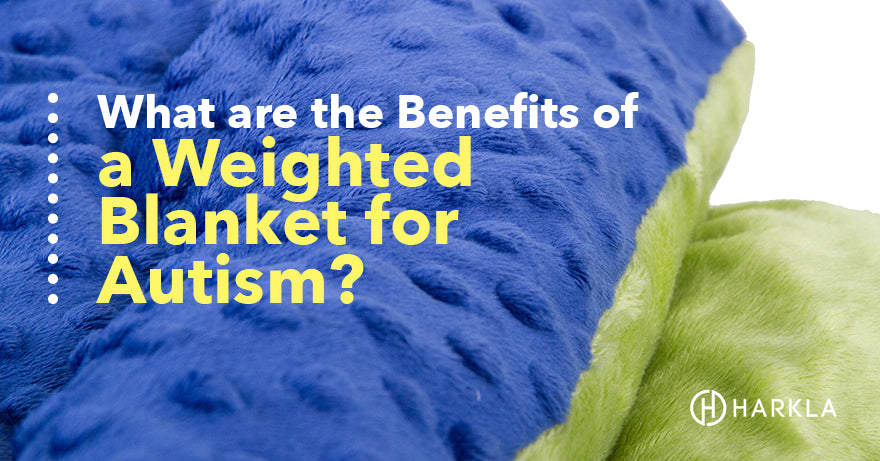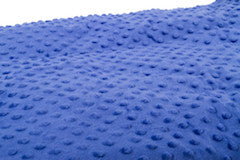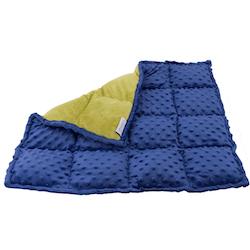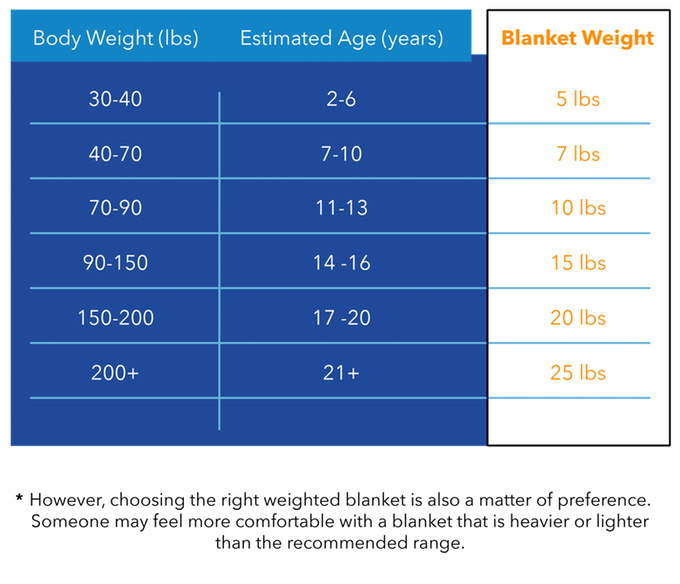Your Cart is Empty
Save up to 20% on all Harkla products & courses during Autism Acceptance Month! Click Here to See the Sale

While weighted blankets have benefits for many disorders, like depression, anxiety, PTSD, and ADHD, this article focuses specifically on the benefits of weighted blankets for those with autism.
These benefits are seen whether the user is an autistic child, adult, or toddler. However, as the weight of the user changes, the blanket should be a corresponding weight as well. We have a graph below to help you figure out which weight is best to get.
Before we dive into the benefits, let’s quickly cover what a weighted blanket it.
A weighted blanket is pretty much what the name implies. It’s a blanket with some extra weight. However, there are variations between weighted blankets.
The first variation is the weight. If you are choosing a weighted blanket, you’ll want to get one that is 10% of your body weight plus a pound or two. If you are purchasing for your child who weighs 50 pounds, then a 7-pound blanket would be perfect.
If you are purchasing a blanket for someone who weighs 180 pounds, then you’ll want a 20-pound blanket.

Another feature that varies between blankets is what is used to weigh it down. Most companies use rice, poly-pellets, or glass beads. At Harkla, we use a combination of PP Cotton and glass beads, so that it has a softer, more comfortable feel.
Weighted blankets also vary in the fabric used. We use an extremely soft, dotted minky fabric. The sensory input is really good if the person using the blanket is a sensory seeker.
You’ll want to choose whichever fabric works best for you.
The answer is yes! There is quite a bit of science that supports the therapeutic uses of weighted blankets. I’ll cover the research shortly, but if you want to dive into it, I’d recommend checking out our article that covers all the science behind weighted blankets here.
The quick overview is the underlying science of weighted blankets is deep touch pressure, often abbreviated to DTP or DPT (Deep Pressure Therapy). Deep touch pressure is basically any gentle pressure that is distributed across the body. A massage or hug could qualify as DTP. Check out our in-depth article about DTP here!
Often, parents who raise children with autism will have to lay with them while they fall asleep. This is deep touch pressure in action. The gentle pressure calms the nervous system and releases serotonin.
Weighted blankets can accomplish deep touch pressure, which alleviates the need for a lot of parents having to hug their child while they fall asleep!
This is the main reason we typically hear when parents buy their autistic child a weighted blanket. It’s very common for children with autism to have sleeping problems, so parents are usually very excited when they discover how much a weighted blanket can help.
There are a few reasons that weighted blankets can help improve sleep for children with autism.
The first is that weighted blankets release serotonin in the body due to the deep touch pressure. Serotonin is an important chemical when it comes to feeling calm and having a stable mood. Children with autism are often low in serotonin.
Not only does the release of serotonin help a child feel calmer, but serotonin is needed to create melatonin in the body. Children with autism also tend to produce less melatonin.
Melatonin is a chemical that your body uses to tell itself that it’s time to go to bed. It’s typically based off of your current sleep schedule. However, since children with autism tend to not produce melatonin very well on their own, they struggle to have a natural sleep schedule.
Many parents will supplement with melatonin, but a weighted blanket could be another great option to try!
Another reason weighted blankets can help improve sleep is that they calm down the nervous system and have been shown to reduce anxiety. Often anxiety is one of the factors that keep children with autism from falling asleep.
The last reason weighted blankets can help is simply that they are heavy and will reduce tossing and turning.
Weighted blankets can be a great way to improve transitions from one activity to another, which typically can be a problem for children with autism.
One example of this that I have seen was teachers using weighted blankets in the classroom when children would come in from recess. Often, children will come in very excited, and getting them to sit down and focus can be difficult. The teachers would dim the lights and use the blankets for 5 to 10 minutes to help the children transition into classroom time.
 This can be used in a number of other scenarios. It could be when your child comes home from school, from playing outside or even transitioning into something like a car ride. Weighted blankets are easy enough to pack along, but you could also use something smaller like a weighted lap pad.
This can be used in a number of other scenarios. It could be when your child comes home from school, from playing outside or even transitioning into something like a car ride. Weighted blankets are easy enough to pack along, but you could also use something smaller like a weighted lap pad.
One of the hardest transition times parents have with autistic children is getting them to go to bed. While we showed how weighted blankets could help a child fall asleep and stay asleep, they can also be used in the pre-bedtime routine.
Perhaps you can lay the weighted blanket on your child while they read on the couch or during storytime. It can have good physiological benefits, but can also become a symbol to represent that it’s time to wind down and get ready for bed.
While not only children with autism have sensory processing disorder, it is a factor for a lot of them. The added weight of the blankets can be great sensory input.
For a lot of children with ASD or SPD, having a feeling of where their body ends can be important for developing body awareness. While this can be accomplished with things like body socks or sensory swings, weighted blankets are another great option.
On top of the weight, you can get the benefit of the fabric, depending on what type of blanket you purchase. The blankets we sell on Harkla are made with an extremely soft fabric called minky, which provides sensory input if you need it. It also holds up well to washing and will stay soft for a very long time.
Along with the minky, we added dots to the blanket that give it an extra amount of sensory input. The soft fabric, plus the dots and the weight of the blanket make it a great option for a sensory seeker. And it’s something they can bring along with them, whether it's to a movie, car ride, or the classroom.
So while you can indirectly improve classroom performance with a weighted blanket by improving your child’s sleep and helping them transition when coming in from recess, there are a few studies showing how deep touch pressure directly improves performance in the classroom!
The studies mentioned here use weighted vests, but the benefits would be the same with a weighted blanket draped over the legs or shoulders, or even a smaller weighted lap pad.
One study found that deep touch pressure had a positive effect on on-task behavior for children when it comes to fine motor skills, like writing, and also had an effect on better in-seat behavior when they are using a weighted blanket.
Weighted blankets have also been shown to reduce self-stimulatory behavior, also known as fidgeting or stimming. This can be a major factor in children not being able to focus. With less self-stimulatory behavior distracting the child, they are better able to focus on what they are learning.
When it comes to sizing your blanket, you'll want to look at the rule we mentioned before about 10% of your body weight plus a pound or two.
We created this chart below to give you a better sense of what size you or your child should get.

Weighted blankets can be a great addition to your sensory toolkit when it comes to raising or caring for a child with autism. There is a reason it is one of our best selling products here at Harkla.
If you have any questions or comments, please let us know in the comment section below! I’m happy to answer or discuss anything with you.
I just wish everyone could afford to buy them….. I for one can’t because of the cost being so high and living on a single income…..
I am wondering what is good for somebody with ASD who is 21 and is 130-140 pounds who also has anxiety and depression and stress and sweats in her sleep?
Thanks for your comments! Weighted blankets can definitely benefit adults, too. They offer the same deep pressure effect and help adults relax, fall asleep faster, and stay asleep.
Let us know if you have any other questions.
Nicole
Harkla Happiness Ninja
My 3 yr old grandsome has Autism. He was diagnoised with it at 18 months. My daughter is a single mom of 4 children.
She has done a lot of research on her own & spent many hours on the computer. He doesn’t talk but my daughter is learning something new every day with him. Lots of trial & errors along the way. The only thing is my daughter gets no sleep at night as he is up down all night. So, this is my question, will a weighted blanket help him sleep at night? I just worry about my daughter getting burnt out from no sleep for days, She has even had to quit her job to be with her son & his needs , He is her world!!
Thxs for your time. Hoping to hear from people that may have same similar lifestyles.
Can these be used w 45yrs or older adults?
Comments will be approved before showing up.



Nicole
June 03, 2019
Hi Saniah,
We would recommend a 15-pound blanket. You can use our weighted blanket without the minky cover if it’s too warm.
Hi Charlene,
Please consider looking up local resources for grants for weighted blankets. If you need any help email us at support@harkla.co.
Thank you!
Nicole
Harkla